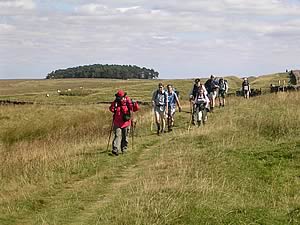 |
|||||||||
|
|||||||||||||||||||
|
|
New
rights of way legislation comes into force 02/05/06 New provisions regarding the use of rights of way by motorised vehicles come into effect today (Tuesday, 2 May).
These provisions in the Natural Environment and Rural Communities Act 2006 will significantly curtail the scope for adding further public rights of way for motor vehicles, known as byways open to all traffic (BOATs), to the definitive map and statement (the local highway authorities' legal record of public rights of way). Rural Affairs Minister, Jim Knight, said: “The Government is delivering our commitment to curtail the inappropriate use of green lanes and ancient ways by motor vehicles, by putting an end to claims for motor vehicular use of them on the basis of historical use, and evidence of that use, by horse-drawn vehicles, as soon possible. “Some of the worst damage is happening in our national parks, which is why we have given National Park Authorities the power to make traffic regulation orders, to commence later this year. “We must ensure that our green lanes, ancient ways and rights of way are protected for the enjoyment of everyone who use these important parts of our countryside, now and in the future.” The new provisions will extinguish – subject to certain exceptions – all unrecorded public rights of way for motor vehicles, so that they cannot then be claimed as BOATs under the fundamental legal principal ‘once a highway, always a highway'. The Act also prevents use by motor vehicles giving rise to any kind of public right of way. A new category of right of way – “restricted byway” – to make these provisions work on the ground is used within the Act. It enables ways where vehicular rights have been acquired by non-motorised vehicles, such as horse-drawn vehicles, to be recorded as restricted byways rather than BOATs, ensuring that the future use of these ways will be consistent with their history. Restricted byways were first introduced by the Countryside and Rights of Way Act 2000. The relevant provisions of that Act and changes to other highways legislation are also taking effect on Tuesday (2 May) in order to dovetail with the commencement of parts of the Natural Environment and Rural Communities Act 2006. Restricted byways can be used by pedestrians, horse-riders, cyclists, and those who wish to use them with a horse and cart or carriage. However, when these provisions come into force it will be an offence under the Road Traffic Act 1988 to drive a motorised vehicle on a restricted byway except in certain circumstances. Because some people rely on a public right of way for motor vehicles to access their land or property, the Act provides for a private right of way for such people, wherever a public right of way for motor vehicles is extinguished, and an exemption from prosecution in limited cases. Notes 1. The key rights of way provisions in Part 6 of the Act are in sections 66 and 67. Section 66 prevents the creation of new public rights of way for mechanically propelled vehicles, while section 67 extinguishes existing public rights of way for mechanically propelled vehicles, where those rights are not already recorded on the definitive map and statement, although this is subject to certain exceptions. 2. Property owners and others with an interest in land may have been relying on unrecorded public vehicular rights of way for access to that land. Section 67 ensures that, if the public right of way for mechanically propelled rights is extinguished, these people are provided with a private right of way to access the land with mechanically propelled vehicles. There is also an exemption from prosecution under the Road Traffic Act 1988 for those using a restricted byway to gain access to their property in certain circumstances. 3. All claims made under Part 3 of the Wildlife and Countryside Act 1981 to establish new rights for mechanically propelled vehicles which were lodged before 20 January 2005 (in England) or 19 May 2005 (in Wales) will be preserved and dealt with under the old law. So also will applications that were lodged after the relevant date but have reached the stage of being determined by the surveying authority. So too will applications lodged by landowners who want to maintain access to their property by mechanically propelled vehicle. 4. The Act will also provide National Park authorities with a power to make traffic regulation orders on rights of way and unsurfaced routes within National Park boundaries but these powers will be commenced later this year. 5. Earlier this year, Defra published advice for Local Authorities, the Police and Community Safety Partnerships on the maintenance of byways and the illegal use of motor vehicles on rights of way. 6. At the same time as establishing Natural England's skeleton body, Defra will commence section 98 (Financial Assistance by the Secretary of State.) This will enable the Secretary of State to provide financial assistance in respect of expenditure incurred or to be incurred in any matter related to or connected with a Defra function. These grant-giving powers are couched broadly and flexibly in order to enable the Secretary of State to fund any function within Defra's remit. This will, for example, enable the Secretary of State to fund directly matters such as social and economic regeneration of deprived rural areas. At present she can do this only through the Countryside Agency or another delivery agency. This section extends to Wales and Northern Ireland.
|
||||||||||||||||||

|
|
||||||||||||||||||
| home | agri-services | pedigree
pen | news | dairy | beef | machinery property | organisations | site map |
|||||||||||||||||||

Department for Environment
Food and Rural Affairs
